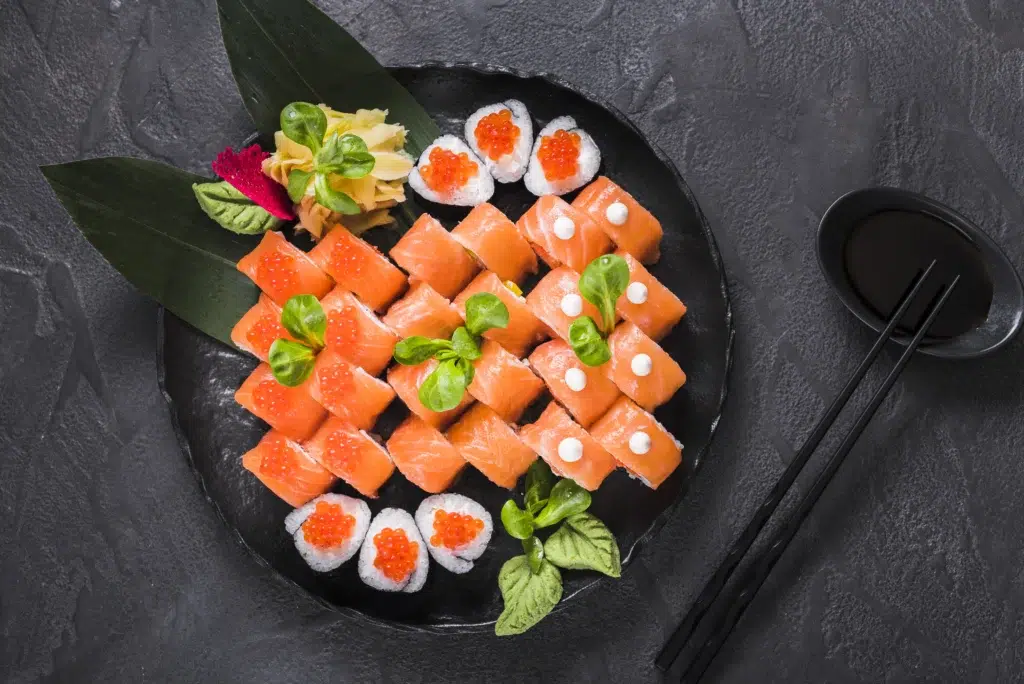
Introduction to Kani
Kani, meaning “crab” in Japanese, takes center stage in many sushi creations. But here’s the twist: Kani can be either the real deal—succulent, fresh crabmeat—or a clever imposter! This imitation crab, often called kanikama, is a processed seafood wonder made from white fish. Yet, it magically replicates the texture, flavor, and even color of its crustacean cousin. So, whether you crave the indulgence of real crab or appreciate a budget-friendly option, Kani offers a delightful double act in the world of sushi.
Types of Kani in Sushi
“Kani” in sushi can be either real crab or a budget-friendly alternative. Authentic crab meat, boasting a luxurious texture and flavor, is the star of premium sushi. But for a more affordable option, there’s surimi, a clever imitation crab made from whitefish paste. Both options add a delicious touch to sushi, though with a price and taste experience difference.
Preparing and Serving Kani
Kani, whether real crab or its clever imitation, earns chefs’ respect. These culinary masters understand the potential to elevate a dish. Through steaming, boiling, or skillful seasoning, they unlock kani’s flavor, ensuring it harmonizes perfectly with the other elements of a sushi masterpiece.
Nutritional Perks of Kani
Kani, often used in imitation crab meat, might surprise you with its nutritional value. Since it’s derived from real crab, kani inherits some of its health benefits. It’s a good source of protein, essential for building and maintaining tissues. But Kani’s benefits go beyond just muscle. Crab meat, and by extension, kani, boasts vitamins and minerals that contribute to overall health. So, that next sushi roll filled with kani isn’t just delicious; it’s also packing a bit of a nutritious punch.
Kani vs. Real Crab
Kani, also known as imitation crab, offers a budget-friendly alternative to real crab meat. While both can add savory notes to dishes, they differ greatly. Real crab boasts a bolder, more nuanced flavor and a satisfyingly flaky texture. Kani, typically made from surimi (ground white fish), delivers a milder, sweeter taste with a chewier bite. Ultimately, the choice depends on your priorities: affordability and convenience may steer you towards kani, while a desire for authentic taste and texture might make real crab the winner.
Enjoying Kani
Kani’s versatility goes beyond simply being an imitation crab. It seamlessly integrates into classic sushi rolls and finds its way into innovative creations by chefs. This ability to adapt to both traditional and modern culinary twists has solidified Kani’s place as a global sushi favorite.
Famous Kani Rolls
Beyond the California roll, the king of kani creations, lies a world of delicious variations. From spicy mayo-dressed kani to refreshing mango and cucumber combinations, these inventive rolls burst with flavor. Whether you crave classic simplicity or adventurous twists, there’s a kani roll waiting to tantalize your taste buds. Dive into the exciting realm of kani sushi and discover a new favorite!
Finding the Best Kani Sushi
Kani sushi, with its delightful imitation crab flavor, offers an exciting culinary quest. From the vibrant heart of Tokyo to your own neighborhood, exceptional options lie in wait. Unveiling these hidden treasures can be an adventure, rewarding you with delectable kani creations. So, prepare to embark on a delicious journey to discover the kani sushi that will tantalize your taste buds.
DIY Kani Sushi
Absolutely! Making kani sushi at home unlocks a world of delicious possibilities. Instead of relying on store-bought options, you have complete control over the ingredients, allowing you to tailor the flavors and textures to your preferences. With just a few key components, you can transform simple ingredients into a delightful and satisfying dish. It’s a fun and rewarding culinary adventure! This way, you can experience the joy of creating and savoring your own unique kani sushi masterpieces.
Etiquette for Kani Sushi
Sushi etiquette goes beyond manners; it unlocks the full potential of kani sushi. By understanding how to handle and consume each piece, you elevate your meal into a true culinary adventure. Following these simple guidelines ensures that you savor the delicate flavors and textures, allowing each bite to be a symphony of taste and tradition.
Wrapping Up
While “kani” translates to “crab” in Japanese, it often refers to the clever imitation crab meat used in sushi. This seafood substitute, made from white fish like pollock, offers a similar taste and texture to real crab at a more affordable price. Kani’s versatility shines in sushi rolls and nigiri, adding protein and a touch of sweetness. Beloved by sushi fans for its accessibility and deliciousness, kani remains a staple ingredient in sushi enjoyed around the world.
FAQs
- Is all kani imitation crab? Surprisingly, no. Kani refers to both real crab meat and imitation crab. Menus or chefs often specify which is used.
- Can I make kani sushi at home? Indeed, you can! With a little practice, crafting delicious kani sushi at home becomes a simple pleasure.
- What are Kani’s health benefits? Kani, especially when real crab is used, is rich in protein and low in calories, making it an excellent choice for health-conscious diners.
- How do identify if sushi uses real crab? Typically, the menu will indicate this, or you can inquire with the staff. Also, real crab usually commands a higher price.
- What’s the best way to enjoy kani in sushi? Ultimately, there’s no single best method. Whether featured in a roll, as nigiri, or in an innovative dish, kani’s versatility shines through in various sushi presentations
in conclusion
In the end, kani embodies a unique blend of tradition and innovation within the world of Japanese sushi. Whether you’re enjoying the delicate flavors of real crab or the ingenious creation that is imitation crab, kani adds a special touch to sushi that is both versatile and universally beloved. Its presence in sushi menus around the globe speaks volumes about its enduring appeal and the important role it plays in bringing sushi lovers together over a shared meal. From the nutritional benefits it offers to the culinary creativity it inspires, kani is more than just an ingredient; it’s a celebration of sushi’s rich cultural heritage and its constant evolution. So, the next time you find yourself pondering over a sushi menu, remember the journey of kani from ocean to table—a journey that reflects the artistry, tradition, and innovation of sushi itself.
Related Articles
- Top Imitation Crab Recipes – Delicious & Easy Seafood Dishes: Since Kani is often made from imitation crab meat, linking to a compilation of recipes can provide readers with practical applications of the ingredient.
- What is the Best Way to Eat Imitation Crab Meat?: This article can offer insights into enjoying imitation crab, enhancing understanding of how Kani may be used in culinary practices.
- What Does Kani Mean in Sushi?: Directly related to the topic, this article can provide deeper insights into Kani’s role and significance in sushi.
- Kani Kama: Delving into the specifics of Kani Kama could enrich the reader’s comprehension of the variety and nuances of Kani in sushi.
- Eating Imitation Crab Raw – Guide: Considering the raw consumption of imitation crab, this guide could clarify safety and taste aspects relevant to Kani.
- Can You Cook Imitation Crab?: This article can complement the primary topic by discussing the cooking versatility of imitation crab meat, often used to make Kani.
- What is Kani Made Of?: Provides a direct answer to one of the fundamental questions about Kani that readers might have.
- Is Kani Considered a Fish?: Offers insights into the classification of Kani, which can be an interesting point for readers curious about dietary considerations.
